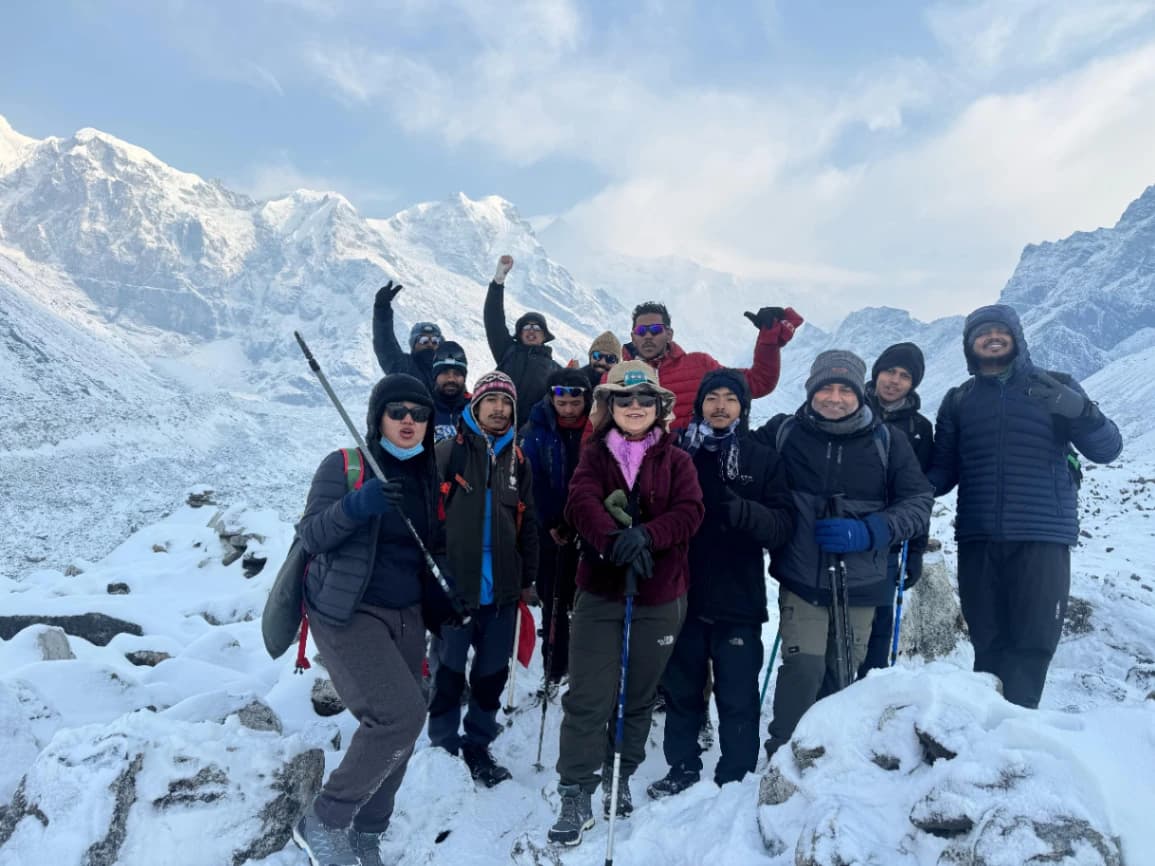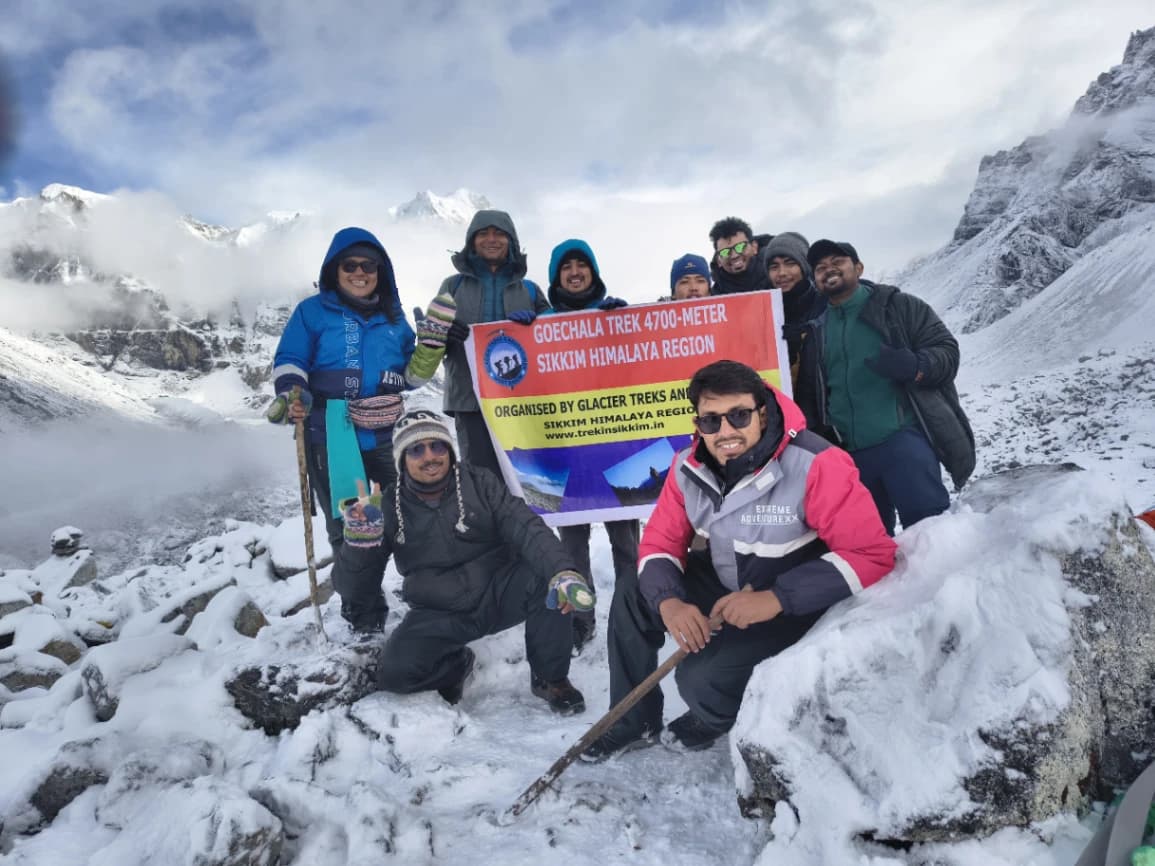Goechala Trek Overview: Before booking, go through the details and check the complete information.
Overview
Duration: 10 days (2 days travel / 8 days trekking/hiking)
Best trek season: March to May and September to November
Grade: Moderate to Difficult
Altitude: 4500 meters Goechala 1 and Goechala 2, and Goechala 3 is 5000 meters
Total Distance of Goechala Trek: 80 km
Main Attraction: 180-degree view of the Mountain
Trek Base Camp- Yuksom west Sikkim
Goechala Trek route plan:
Arrival at Baghdogra Airport or NJP New Jalpaiguri Railway Station, and then drive to Yuksom-Yuksom-Sachen-Tshoka-Dzongri-Thangsing-Lamuney-Goechala back Lamuney Thangsing-Tshoka-Yuksom-Airport or station.
About Goechala Trek
Goechala trek, one of the most magnificent and popular treks in India, is located in the beautiful hilly state of Sikkim. The trek’s exceptional beauty, grace, and glamour of the Kanchenjunga range will always entice visitors and admirers to it from all parts of the world. The trek’s grandeur is at an all-time high since it allows one to witness pure streams, cool forests, and open, picturesque meadows at this high altitude. Ranging from beginners to experts, the Goechala Trek will never fail to satisfy anyone and everyone.
Best Time and best season for Goechala Trek:
The right time selection is vitally important during the Goechala trek. The best three preconceived months to go for Goechala are April, May, and June, September, October, and November. In these months, the weather remained pleasant, the sky is clear, and the view of the Himalayas is outstanding. During spring and autumn, the temperature is relatively cool, which is ideal for high-altitude trekking. One cannot go during the monsoon because of the rain, landslides, and slippery trek path.
Goechala Trek Difficulty Level:
The difficulty of the Goechala Trek is moderate to challenging. It could be suitable for those trekkers who have already had experience. As it occupies more days of hiking than a simple one, it needs to have an okay fitness level. The trek reaches high points of 4500 meters/15000 feet; it is better to be physically prepared. The trek is not extreme, but the weather conditions and altitude make it difficult for those who are not used to such treks. Hence, prior experience and acclimatization are preferable.
Goechala trek cost
Usually in between Goechala Trek costs starting from ₹19,500 to ₹80,000 per individual. The costs are inclusive of accommodation, food, guide fees, camping fees, equipment, and convenience for the trek. Since most trekking agencies in Sikkim offer varying services, the cost of a trek can fluctuate due to periods of demand and supply issues. The trekkers may also experience additional expenses in the form of extra days due to bad weather, equipment rentals, or their personal equipment logistics, etc. Hence, one should be careful to hike with a well-known and reliable trekking agency to avoid trouble.
Goechala Trek booking and trekking Package:
Goechala trek booking is done through several trusted trekking agencies.
either local or those operating online.
Booking companies offer comprehensive Goechala trekking packages, which may include permits, experienced guides,
accommodation, meals, and transportation.
Some of the things to consider in the trekking package include: Experienced, certified guides Detailed trekking itinerary with contingency plans
Group size and ratio of guides and trekkers. Ideally,
Goechala trek booking should be done before the trek departure date, especially during the festival and post-monsoon trekking seasons when entry permits are in high demand.
trek
Goechala Trek reviews
As for Goechala Trek reviews, most of the past trekkers were astonished by the views and mentioned the difficulty they had to face to reach such a reward. People often talk about Kanchenjunga baths and the outstanding landscape, or the calmness at high altitudes. The moderate level of complexity of the trek and new comrades are among the peculiarities that are highlighted. Still, most of them underscore the need for physical preparation and proper acclimatization for the challenging parts of the route.
Goechala Trek Shor Itinerary
Day 1: Arrival in Yuksom. Yuksom is the base camp for the Goechala Trek. Normally, people learn the needed details on this day and get prepared for the event.
Day 2: Yuksom to Sachen. Going to the first point of interest takes 4-5 hours.
Day 3: Sachen to Tsokha. Moving to the next place involves following 4-5 hours.
Day 4: Tsokha to Dzongri. One more place visited, and the day of accommodation at this point, as the event should provide acclimatization. This is the most lasting part of the itinerary as for it is needed to stay there for 5-6 hours.
Day 5: Dzongri to Dzongri Top and back to camp. Refresh and after that leave for the next camp, Thangsing.
Day 6: Thansing and Lamuney, just like 1 and a half hours to reach Lamuney.
Day 7: Lamuney to Goechala La. The most difficult day is for people spend it going to the peak of the mountain in the late night to observe the shine of Kanchenzungha at dawn. From the Lamuney, it takes 3 hours to summit the pass, and the distance is 3Km approx. After sunrise and taking of enjoyment, and getting back to Lamuney, have some meals, and then descend to Kokchurung.
Day 8: Kokchurung to Tshoka 15Km through the dense forest and rhododendron forest.
Day 9: Descent to Yuksom from Tshoka, it takes 6 hours to reach Yuksom.
Day 10: Yuksom to Baghdogra Airport.



-1751707057028-587054211.webp)











